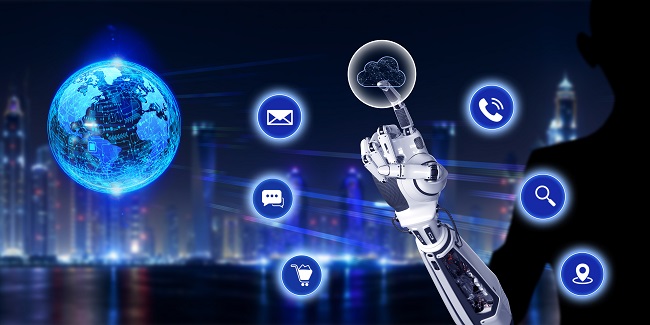Where 5G-A Meets AI: 5 Telco Use Cases
Around the globe, leading telecom operators are no longer talking about 5G-A and AI as future aspirations – they're actively deploying them in tandem to drive smarter networks, immersive services, and enterprise transformation.
Within this domain, there are a few standout examples of where telcos are operationalizing the convergence of 5G-Advanced and AI today.

1. SK Telecom (South Korea): AI-First Strategy on a 5G-A foundation
SK Telcom (SKT) set forth its ‘AI Pyramid Strategy’ to accelerate innovation centered around three key areas: AI Infrastructure, AI Transformation (AIX) and AI Service.
- AI Infrastructure, which consists of data centers, AI semiconductors, and multi LLM, will serve as a technology platform that forms the basis of SKT as an AI company.
- AI Transformation (AIX) of SKT’s core business areas such as mobile, broadband, and enterprise, as well as new business areas like mobility and healthcare, will be pursued to reach a new level of productivity and customer experience.
- AI Service, SKT has announced the official launch of ‘A.’ and plans to build a globally competitive personal AI assistant service by leveraging its telco and AI assets.
- A. (pronounced “A dot”) is an artificial intelligence chatbot which has a character that speaks to people. SKT has integrated its various services, from music streaming to e-commerce, into A.
- A. users can create and customize an AI character that reflects their personalities, and communicate with the character through conversations or text messages, and ask for diverse information.
- A. is currently only available in Korean. But the company is in the early stages of exploring an international launch for the service.
SKT will strengthen its own AI capabilities and collaborate with diverse global players to expand its presence in the global AI market. By 2028, SKT will triple the proportion of its AI-related investments and become a global AI company with revenue of KRW 25 trillion.
2. China Mobile (China): Intelligent network operations at massive scale
China Mobile is applying AI to run one of the world’s largest mobile networks more efficiently – and is already testing 5G-A capabilities such as integrated sensing and intelligent slicing. China Mobile is unleashing its “AI+NETWORK” innovation program to promote high-quality and sustainable development where remarkable progress has already been made in three areas.
- Leading information infrastructure: China Mobile operates the world’s largest 5G and fiber broadband networks as well as fully cloud-based 4G/5G converged core networks and rapidly growing computing power. Here, leading information infrastructure underpins digital-intelligent transformation across industries.
- Innovation-enabled information service systems: The company has 90,000 5G-Advanced 3CC CA cells and 450,000 RedCap sites. It is also the first operator to bring Network Data Analytics Function (NWDAF) to 5G-Advanced for experience assurance. Its wireless AI applications are making a huge difference across its networks to enhance user experience.
- Digital-intelligent Transformation of Network O&M through Autonomous Networks: The company is working on building an end-to-end fully automated digital-intelligent operations pipeline – where automation is the foundation and AI technology the innovation engine.
China Mobile has been prioritizing the promotion of AI technology and the network development of 5G-Advanced. The combination of 5G-A’s real-time responsiveness with AI’s decision-making allows China Mobile to scale services like smart manufacturing and reduce operating overheads in a sprawling, complex network.
3. e& (UAE): 5G-A & AI for smart cities and enterprise services
e& is in the process of deploying 5G-Advanced, which is set to revolutionize connectivity with its enhanced capabilities, offering a wide range of new service opportunities across various sectors, including consumer, IoT, and enterprise. To add to this, e& UAE has a clear blueprint for AI strategic application in the telco sector and beyond.
- e& has integrated more than 400 AI use cases and 160 machine learning (ML) models across its operations. The company has also created a dedicated Robotic Process Automation (RPA) team and established a Robotics Centre of Excellence (CoE).
Whether launching the first AI-powered telecom store in the world or deploying AI-driven recommendations, e& UAE ensures every customer enjoys a seamless and personalized experience. e& UAE is leveraging advanced GenAI technologies to deliver real-time personalized recommendations, customized news feeds, and tailored product suggestions that enhance customer engagement and satisfaction.

4. Telstra (Australia): Connected future 30 strategy focusing on AI and Network
Telstra's "Connected Future 30" strategy, unveiled in May 2025, is a five-year roadmap (2025-30) focused on leveraging AI and network advancements to maintain its competitive edge and drive digital transformation in Australia. Under this strategy, Telstra is building an autonomous network with self-optimizing AI capabilities across the cloud and network layers, alongside internal AI tools for efficiency.
Telstra is essentially rethinking its core business by transforming its network into a smart, AI-driven platform. The telco is already working on deploying its programmable 5G Advanced network.
This strategy will help Telstra to develop and monetize a network-as-a-service (NaaS) platform, empowering enterprises and developers via network APIs and customized SLA-based connectivity. This platform allows businesses to select and pay for pre-integrated cloud and networking services as needed. For Telstra, the AI-enabled network is itself the product.
5. Verizon (USA): Accelerating 5G-A with enterprise AI at the edge
Verizon is evolving its 5G-Advanced strategy by building AI-native private networks and Mobile Edge Compute (MEC) solutions to serve enterprise clients, with live deployments and partnerships.
For example, the telco has launch a 5G Private Network + Enterprise AI platform. This combines Verizon’s private MEC with NVIDIA’s AI software stack, enabling real-time inferencing for robotics, AR/VR/XR, computer vision, generative AI, and industrial automation – delivered securely and at ultra-low latency. This initiative is designed to empower enterprises by delivering real-time AI applications directly at the edge, demonstrating the transformative potential of this technology across various industries.
Further, the telco has also launched Verizon AI Connect integrating edge-to-cloud network intelligence, aimed at hosting large-scale AI workloads directly on their programmable 5G-A infrastructure.
In summary, Verizon is leveraging 5G-Advanced and AI to deliver programmable, low-latency networks that power next-gen enterprise and consumer experiences – from real-time industrial AI to network slicing for video and beyond.
Benefits for telcos from 5G-A and AI convergence: Operational efficiency and revenue growth
The convergence of 5G-A and AI is more than just a technology upgrade – it’s a strategic enabler that delivers measurable benefits across the telco value chain. From reducing operating costs to unlocking new revenue streams, early adopters are already realizing the returns of building intelligent, AI-native 5G-A networks.
Operational benefits: Smarter, leaner, faster networks
- Automation & OPEX Reduction: AI-driven automation in 5G-A networks reduces the need for manual intervention in operations, fault management, and optimization. Vodafone’s deployment of AI-based performance management (called the United Performance Management (UPM)) led to a 70% reduction in major incidents, directly impacting operational stability and cost savings.
- Energy Efficiency & Sustainability: AI models optimize energy usage by dynamically switching off unused base stations or adjusting power output in real time – critical in massive MIMO environments. For instance, Orange has deployed an AI-powered energy management system across its European networks, achieving up to energy savings during off-peak hours by intelligently powering down network resources without impacting user experience.
- Self-Optimizing Networks (SON): AI allows 5G-A networks to adjust coverage, handovers, and capacity allocation autonomously – delivering better user experience while minimizing human error. For instance, Telefónica has deployed AI-powered SON capabilities in its network, thus, helping create a network that can adapt to provide better quality of service or reduce response times.
- Smarter Customer Service: GenAI enables telecom operators to automate routine support queries, improve response accuracy, and reduce pressure on contact centers – ultimately enhancing customer satisfaction and lowering operational costs. For example, T-Mobile US has implemented its OpenAI-powered IntentCX platform, which handles routine customer inquiries autonomously, freeing up agents to focus on more complex interactions and shortening resolution times.
Revenue benefits: From connectivity to intelligence
AI-as-a-Service (AIaaS): With 5G-A’s low latency and integrated edge compute, telcos can package AI capabilities (such as analytics) as a service to enterprise clients. Orange Business, for example has launched a new multi-LLM solution called ‘Live Intelligence’, that enables businesses to leverage the power of GenAI to improve operational efficiency and customer experience without compromising the security of their data.
GPU-as-a-service and AI-as-a-service are closely related, with GPUaaS being a key component that enables many AIaaS offerings. GPUaaS provides access to powerful Graphics Processing Units (GPUs) via the cloud, which are essential for the computationally intensive tasks involved in training and running AI models. AIaaS then is a broader service that provides access to AI capabilities and tools, often leveraging GPUaaS for its underlying infrastructure. The growth forecast of GPUaaS from telcos is a great proxy of telcos proving AIaaS.
- New Vertical Revenues via Edge + AI: Smart manufacturing, precision agriculture, logistics, and healthcare are increasingly demanding real-time AI execution at the edge. 5G-A provides the pipe, while AI delivers the intelligence -together creating platform-based monetization models. For example, Deutsche Telekom partnered with Volkswagen Group Logistics on the “AutoLog”. Using 5G and edge compute, they implemented AI-controlled digital twins and automated vehicle marshalling systems – dramatically improving operational safety and throughput while opening the door to new logistics service revenues.
- Enhanced ARPU through Personalization: Machine learning helps telcos offer the right bundle, content, or device to the right customer at the right time – driving upsells and reducing churn. For instance, Vodafone implemented a Customer Data Platform (CDP) to deliver personalized portal experiences, resulting in a 10–30% uplift in conversions, along with higher data usage.
- Monetizing SLA-based Experiences and Slicing: AI enables dynamic SLA-based slicing in 5G-A, allowing operators to charge premium rates for latency-sensitive or high-throughput services. For example, AIS Thailand has launched its “Living Network”, delivering real time, AI-driven 5G-A experiences. AIS also uses AI to promote 5G acceleration packages tailored to users’ needs, offering relevant services, improving customer acquisition, and increasing 5G adoption. The network identifies high-value users and adjusts bandwidth allocation dynamically to ensure seamless service, even during peak times.
The message is clear: 5G-A gives the telco network more speed and reach, but AI gives it brains. Operators that build this synergy into their strategy will not only optimize operations – but also become pivotal players in powering the AI economy.

Conclusion: Smarter networks for a smarter future
As the telecom industry moves into a new era of intelligent infrastructure, the fusion of 5G-A and AI stands out as the most consequential transformation in decades. No longer are telcos defined solely by towers and spectrum – they are becoming enablers of intelligent, responsive, and value-rich digital ecosystems.
5G-A provides the technological scaffolding: ultra-reliable low-latency communication, intelligent slicing, enhanced uplink, and distributed compute. AI brings the intelligence layer: automating decisions, optimizing resources, enabling personalization, and powering next-gen enterprise solutions. Together, operators that adopt an AI-native approach to 5G-A will gain far more than network efficiency. They’ll unlock:
- Smarter customer interactions powered by generative AI
- Profitable enterprise services built around edge AI and slicing
- Sustainable operations through predictive, self-healing, energy-efficient networks
- And most importantly, a new role in the AI economy – as platform providers, not just connectivity players
The telecom winners of tomorrow are already laying the groundwork today. Their networks don’t just move data faster – they think, adapt, and create value in real time.
With 5G-A and AI working together, the smart network has finally arrived.
Disclaimer: Any views and/or opinions expressed in this post by individual authors or contributors are their personal views and/or opinions and do not necessarily reflect the views and/or opinions of Huawei Technologies.
Leave a Comment